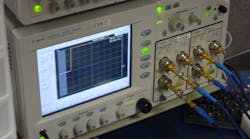This file type includes high-resolution graphics and schematics when applicable.
Modern test instruments utilize digital technology in place of the analog circuitry that was used in years past. Typically, high-performance analog-to-digital converters (ADCs) and digital-to-analog-converters (DACs) are used in today’s test equipment. This has enabled waveforms to be analyzed and generated with better fidelity at higher frequencies and with increased dynamic range in comparison to previous-generation test instruments. In the application note, “Demystifying the Impact of ADCs and DACs on Test Instrument Specifications,” Keysight Technologies discusses common converter characteristics and their effect on test instrumentation performance.
The application note begins with an explanation of the characteristics of ADCs and DACs. Integral nonlinearity (INL) and differential nonlinearity (DNL), which are important indicators of a converter’s accuracy, are both described. The performance tradeoffs between bit resolution and sampling rates are also explained in the document. Furthermore, readers are provided with a description of how dynamic range is directly related to bit resolution, as well as a description of sampling rates in relation to bandwidth.
Several performance-enhancing techniques that can be applied to ADCs and DACs are explained. The interleaving technique is analyzed, as it offers a means to improve sampling rates without sacrificing bit resolution. Dithering, which is the process of adding a small amount of random noise to a signal before it enters a converter, is also discussed. By implementing the dithering technique, spurious-free dynamic range (SFDR) can be improved. Additional performance-enhancing techniques include oversampling, interpolation, and decimation, which are all explained in the document. A short overview of the undersampling technique is presented as well as a brief analysis of the Hilbert transform.
The application note continues with an explanation of how converter specifications are related to instrument performance. Dynamic specifications, such as signal-to-noise and distortion (SINAD), effective number of bits (ENOB), and spurious-free dynamic range (SFDR), are important to understand when analyzing system performance. Lastly, an overview is presented of ADC and DAC implementations in specific test instruments, including signal analyzers, oscilloscopes, digitizers, arbitrary waveform generators (AWGs), and vector signal generators (VSGs).
Keysight Technologies Inc., 1400 Fountaingrove Pkwy., Santa Rosa, CA 95403; (707) 577-2663

